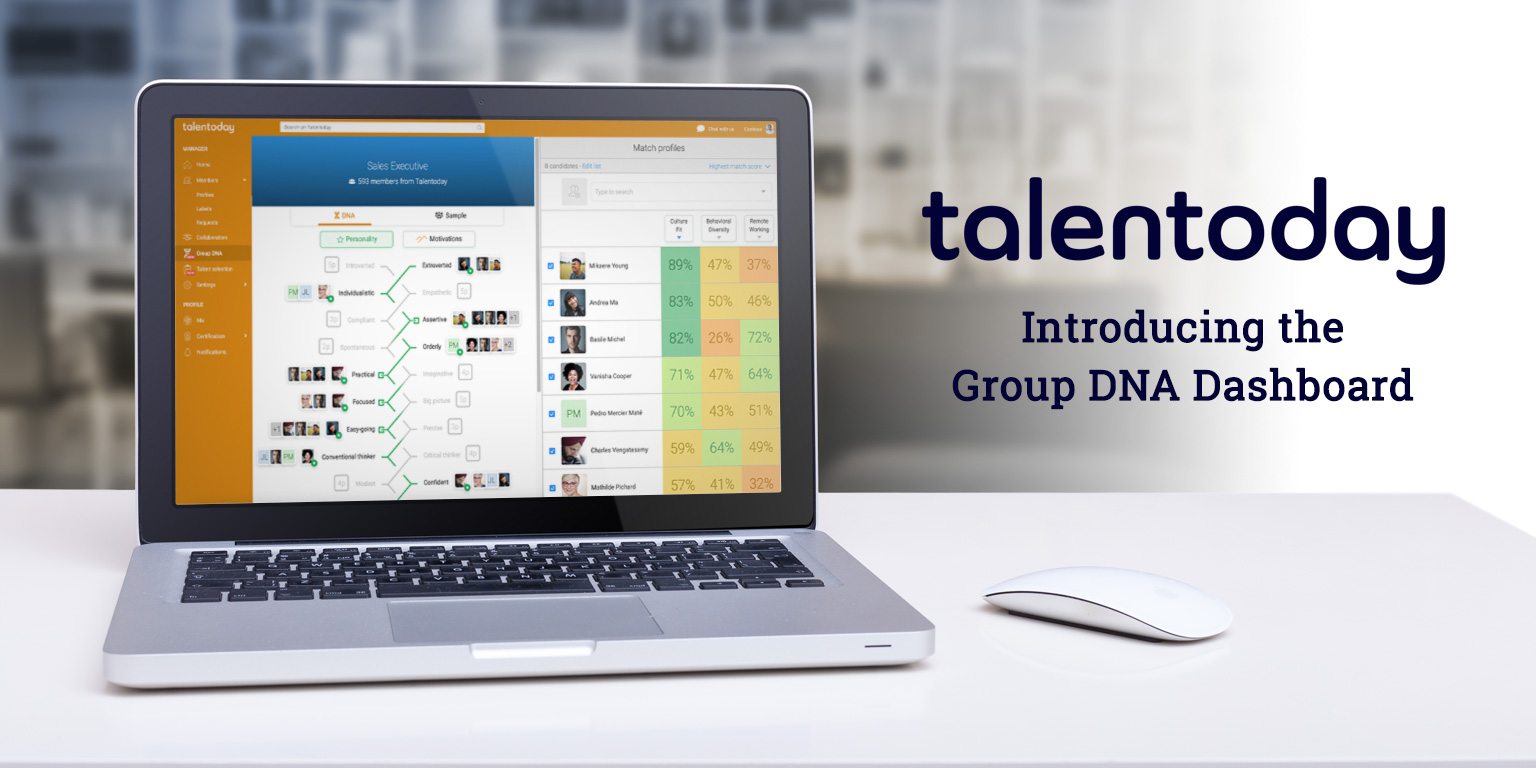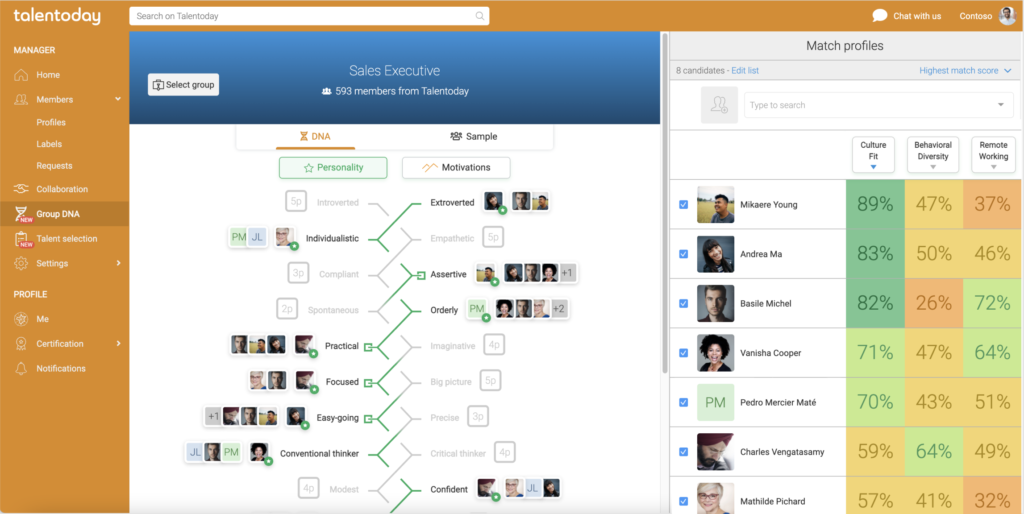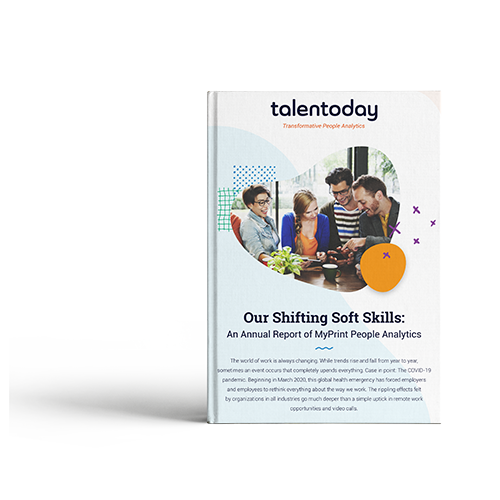Visualize Team Connections with the Group DNA Dashboard
Recruiting and building teams based on hard skills alone has proven to be an inefficient and incomplete hiring and management strategy in today's world of work. That’s why Talentoday has created the Group DNA Dashboard. It’s a new way to visualize the team profiling and talent matching tools first introduced by Group DNA (GDNA).
Now available in the Talentoday Manager platform, this powerful analytics tool leverages soft skill data to paint a complete cultural picture of a team, company or position. Users can also compare this key information alongside individual profiles to draw important connections between teammates.
Here’s how HR professionals can use the Group DNA Dashboard to power better decision making.
Discover the Group DNA Dashboard
Talentoday’s Group DNA Dashboard helps HR leaders visualize three key areas of people analytics: Culture Fit, Behavioral Diversity and Remote Work.
First, the new dashboard assesses culture fit, a key indicator of potential employee retention rate. This is done by evaluating how an individual matches with the predominant poles of the GDNA, zeroing in on personality traits and motivations that reflect the core values of the targeted team or company.
Second, the tool provides an analysis of behavioral diversity. This is a representation of the potential prevalence of diversity of thought, varied opinions and creative viewpoints in the workplace. To calculate this percentage, the GDNA Dashboard calculates the extent to which an individual diverges from the non-predominant poles of the Group DNA. The higher the percentage of distance, the more an individual can bring balance to the behaviors of a targeted team or company.
Finally, the GDNA Dashboard was built with today’s workplace in mind, dedicating space for key remote working insights. Individual profiles are compared against the results of our Remote Worker Group DNA profile to identify which teammates may excel in a work-from-home or hybrid environment.
Personalizing Your Results
In addition to visualizing these results all at once, users can also sort any matching results according to culture fit, behavioral diversity or remote working ability. This ensures that your decision making process can be as granular as you want it to be.
For example, a design team may be most interested in building their team around creative thinking. In this case, users could use the dashboard to maximize behavioral diversity matches.
On the other hand, a technology team may put more emphasis on boosting retention rates in a tight labor market. To attract the right talent with the skills needed to succeed, this might mean focusing on offering work flexibility and remote work opportunities. Therefore, this team’s dashboard may filter for remote work abilities to find the top matches in these asynchronous environments.
Visualize Team Connections with the Group DNA Dashboard
Interested in seeing how the Group DNA Dashboard helps leaders identify soft skills connections on their teams? Contact our Talentoday team today to learn more about how our latest feature is changing the way teams visualize and act upon soft skills data!
4 Ways Companies Can Turn the Page on Turnover
It takes a lot of work to hire a new employee. Just think of all of that time and effort spent writing job descriptions, sourcing candidates, hosting interviews and making difficult decisions! At the end of all of it, everyone involved should have a cause for celebration. Unfortunately, high turnover rates can put a damper on any organization’s bright plans for the future. Instead of focusing on organizational and individual career growth, HR teams and managers must race to fill gaps while pushing their employees to do more with less.
Indeed, employees are feeling this strain. Recent polling presented by HR Dive indicates that 62 percent of employees are feeling an extra pressure to do more at work, triggering 33 percent to note a marked decline in workplace happiness. All of these negative sentiments bubbled up to a troubling conclusion: “a third of survey-takers said their desire to stay at their job has decreased; another third said they are actively thinking about leaving their organization.”
For struggling HR teams, moving forward while you’re stuck looking backwards to solve turnover troubles is simply unsustainable.
A Troubling Example
A recent study from the Wharton School tells the story of turnover pains in microcosm. Researchers worked with a Chinese cell phone manufacturer to track failure rates of their products over the course of four years. With an unprecedented amount of access to company data, they were able to pinpoint the exact date, time and location of assembly of each phone - along with the staffing levels at the time. Unsurprisingly, as weekly turnover rates in factories ticked up, so did the rate of product failure. The associated costs amounted to hundreds of millions of dollars.
The takeaways for the employer turned some perceptions of their workplace upside down. While managers assumed that replacing a vacancy with an equally experienced person would solve the problem, this, too, proved to be disruptive. “That person who left has some knowledge that’s not easily replaced,” noted Ken Moon, professor of operations, information and decisions at Wharton. “Even though an assembly line is not a deeply collaborative workplace, there is still a need to coordinate with those around you. And that matters.”
Four Ways to Rethink Turnover
Examples like the one identified by the Wharton School represent a warning call for employers. While recruiting to fill gaps on teams is necessary, there needs to be a renewed focus on retention. Institutional knowledge is not accrued overnight. When teams are stretched too thin, employers can have little hope of providing proper onboarding and ongoing training to build that knowledge.
In order to get from high turnover rates to promising retention rates, companies need to rethink turnover with four key areas of focus in mind: DEI, Growth, Communication and Culture.
- Diversity, Equity and Inclusion: Study after study has made it clear that employees want to work for companies that value diversity. Critically, they can also tell when they’ve been sold a bill of goods. Mentioning these key terms and commitments in job descriptions and your company’s digital presence is no doubt an important first step. Yet, not following through on those commitments risks alienating your workforce. Steps like hiring a team focused on DEI efforts, launching affinity groups and instituting regular check-ins with employees can take a company from words to action.
- Growth Opportunities: No one wants to take on a new role just to stay stagnant. According to Forbes, 76 percent of employees stated that they are more likely to stay with a company that offers continuous training. When this doesn’t happen at work, one in two employees decide to pursue learning opportunities on their own. This opens employers up to risk. Rather than risk losing employees as they look elsewhere for development opportunities, build a robust, in-house training system that takes employees from onboarding to continuous skills development.
- Holistic Communication: Communication cannot be a one-way street. This was true when a majority of employees worked in a single location, and it’s even more true with the rise of remote and hybrid working environments. There’s no quicker way to lose talent than to make them feel as though their voice is not heard. Expanding opportunities for feedback through options like anonymous surveys and virtual town hall meetings is key in a decentralized workplace.
- Adaptable Culture: By now, it’s tiring to repeat that culture is crucial (but it is!) However, rather than doubling down on fitting employees into a predetermined box of the way things are, companies need to be open to expanding their culture through addition, not exclusion. Steps like diversifying the talent pool and tapping into the soft skills and people analytics data of your existing workforce can help inform the direction of your ever-changing organization. Culture is a living thing; it’s time to treat it that way!
Are you ready to go beyond a one-size-fits-all approach to managing your team to avoid costly turnover? Learn how Talentoday’s MyPrint assessment can provide a deeper understanding of your employees personality traits, motivations and behaviors.
Recruiters are Burned Out, Too
We’ve all seen the headlines warning of “The Great Resignation” or “The Great Realignment” or “The Great (Insert Your Favorite Description Here)” that has shaken up the employment landscape over the last few years. In many ways, it is true that the tables have turned when it comes to the power balance between job seekers and employers. Companies have had to respond to a tightening of the labor market and a ratcheting up of demands from talent. Less remarked upon, though, is the effect that this phenomenon has had on the people we often expect to handle the hiring process: recruiters.
Recruiters find themselves caught between hiring managers desperate to fill vacant spots and job seekers insistent on receiving more from their employers. Throughout it all, they’ve been ghosted, pressured, villainized and often taken for granted. Are employment professionals finally reaching their breaking point?
HR: Harsh Realities
HR teams are often the canaries in the coalmine when it comes to concerning hiring trends. Think of it this way: The journey from posting a job listing to sourcing candidates, scheduling interviews, negotiations and, ultimately, onboarding can take weeks or even months. When an explosion in demand suddenly outweighs the available supply of talent, recruiters feel the effects first. By the time employers are ready to raise red flags due to delays in their hiring processes, recruitment professionals may already be seeing red.
Today, the effects of an exasperated hiring market are certainly being felt by recruiters. When polled, nearly one third of recruiters said they experience extreme stress on a weekly basis because of their work. Digging even deeper, this same research found that 77 percent of high-ranking recruiters are open to changing jobs, along with 65 percent of HR professionals. Now, the question is: What do we do when the people helping us navigate the Great Resignation resign themselves?
HR: Humanized Recruiting
Automation is the hot topic in the world of human resources these days, and with good reason. The application of people analytics at scale has the potential to positively impact hiring, retention and the way we work in ways we can only begin to imagine. Yet, what gets lost in these conversations is the fact that human beings will still be at the center of all of it. While many automated processes have helped to streamline the jobs of recruiters, it still hasn’t changed the fact that a living, breathing person is being tasked with creating important connections between job seekers and employers.
With that in mind, here are three ways that organizations can support their weary recruiters: invest in onboarding, celebrate success and prioritize mental health for all.
- Invest in onboarding. It takes a lot of work to hire someone. After all of the time and energy that goes into finding the right candidate for a job, it is downright dispiriting to lose that person just as quickly to turnover. One way to boost retention rates is to ensure a smooth onboarding process. Unfortunately, recent research indicates that only 44 percent of recruiting leaders said that they believed their onboarding processes were successful in introducing new hires to the company culture. Beginning any job with miscommunication only makes it more likely for bigger issues to bubble up down the line. Now, with the rise of remote and hybrid work environments, setting expectations early on with a clear onboarding process is more essential than ever.
- Celebrate success. Okay, maybe employee of the month plaques have fallen out of style, but there are still ways to show appreciation for a job well done. Now, it’s all about personalizing praise. One recruiter might appreciate their manager giving them a shout out in a public setting. Another recruiter might be more motivated by external rewards, such as a bonus for a job well done. It’s important to get ahead of the sentiments that lead to burnout by supporting employees in a way that speaks to their individuality.
- Prioritize mental health for all. It’s one thing to write a few sentences about valuing mental health to put up on a website; it’s another thing to follow through. Recruiters are seeing firsthand that job seekers today value opportunities where employers make their wellbeing a priority. After a while, it’s only natural that they, too, might consider making a similar move! Employers that make the decision to double down on mindfulness are seeing it payoff in a big way. A 2022 study by Deloitte found that these employers saw a return of nearly $5 for every $1 invested in mental health services.
Resign. Recruit. Repeat.
If employers take away anything from the Great Whatever You Want to Call It, it should be that employees of all kinds want their needs to be heard. Recruiters may have been the first to sense the shifting employment landscape, but now they find themselves in the center of a swirling sea of doubt. To avoid falling into a treacherous cycle of resign-recruit-repeat, employers must be ready to support their recruiting teams.
Are you ready to go beyond a one-size-fits-all approach to building your team? Learn how Talentoday’s MyPrint assessment can provide a deeper understanding of your employees personality traits, motivations and behaviors.
Putting People First in People Analytics
From financial services to manufacturing, big data has been revolutionizing the way industries work for years now. An explosion in the volume of available information and powerful tools able to analyze and apply learnings from it all have led to more efficient and effective workplaces processes. It was only a matter of time before data-driven solutions changed the way we think about human resources, too.
Now, people analytics (PA) has completely reshaped hiring and workforce management for organizations of all shapes and sizes. In fact, big data in HR is big business. According to the Harvard Business Review, “up to 70% of executives consider the implementation of PA capabilities as a top priority and predictions are that the value of the global big data analytics market will be around $68 billion by 2025.”
But is there a hidden cost behind this shift to data-driven decision making?
People Analytics 101
MIT Sloan professor Emilio J. Castilla defines people analytics as, “a data-driven approach to improving people-related decisions for the purpose of advancing the success of not only the organization but also of individual employees.” The key in this definition is the dual impact being described; properly designed, these applications can benefit both organizations and individuals alike.
To get there, companies are tasked with analyzing countless data points. Consider all of the valuable information HR teams gather from the start of the hiring process through the duration of an individual’s employment lifecycle. This information can include but is not limited to:
- Resumes
- Interview Responses
- Soft Skills Assessments
- Performance Reviews
- Salary History
Each bit of data reveals a new portion of the picture of the complex individual behind a given job title. Add enough of these pieces together and a detailed panoramic view of an entire organization comes into focus. That’s the real power of people analytics - the potential to unlock connections within an organization previously unseen by traditional HR practices.
How to Keep the People in People Analytics
Unfortunately, there’s a flip side to companies embracing PA in a big way. When mishandled, these efforts can send the wrong messages to a workforce and - even worse - double down on biased decision making.
Here’s how to avoid the potential dehumanizing effects of applying people analytics at your organization:
- Practice data due diligence. Put bias in, get bias out - it’s as simple as that. As pointed out in, “Using People Analytics to Build an Equitable Workplace” historical data can come with years of bias already baked into it. For example, previous hiring practices or review structures may have been inherently biased against particular groups of people. Steps very well may have been taken to rectify these issues. However, your AI tools will not understand these changes when processing the data. Therefore, “while algorithms can help interpret past data and identify patterns, people analytics is still a human-centered field, and in many cases, especially the difficult ones, the final decisions are still going to be made by humans.” Understand and accept the limitations of automation upfront, then confront them with thoughtful human intervention.
- Communicate your commitment to humanity. The core of people analytics (and human resources, for that fact) is people. It’s not about cold, calculated efficiency; it’s about making work better for everyone at a basic, human level. Leaders need to communicate this overarching goal at every step of the way when implementing PA principles across an organization. Rather than boiling people down to facts and figures, express the ways in which analyzing these data points can lead to improved interpersonal relationships, personal and professional growth and, ultimately, a happier workforce.
People First
At best, the big data revolution can be interpreted as a hopeful reimagining of our future. At worst, it is a cautionary tale about what happens when we reduce our humanity to a series of data points. People analytics has the potential to positively impact the way we build and manage teams. Yet, that potential will be squandered if we fail to recognize the human beings behind the data.
Talentoday provides science-driven people analytics to fuel better decision making at all points of the employment life cycle. Learn how our MyPrint assessment can provide a deeper understanding of your employees’ personality traits, motivations and behaviors.
Making Mental Health a Priority at Work (For Real)
Mental health is now big business. After all, it is estimated that companies lose up to $500 billion annually as a result of the negative effects of mental health problems on productivity. In response, each year companies will celebrate occasions like Stress Awareness Month and Mental Health Awareness Month in very public ways. Like clockwork, when the first of the month strikes, splashy videos and powerful statements hit social media. For the most part, the folks saying things like, “We value employee wellness,” and “Mental health is a priority for our team,” mean well.
Unfortunately, all too often, that's where the commitment ends.
While big talk about mental health might be enough to drive engagement online and attract new job candidates, it is not a long-term solution for any company that truly values retention, productivity or authenticity. For that, leaders need to move from words to action.
The Great Resignation: A Wellness Wakeup Call?
Employers expressed plenty of panic in the early days of the Great Resignation. “What could be driving an unprecedented number of employees to quit?” was frantically being asked in boardrooms and newsrooms across the country. The obvious answer to most questions lately can be traced back to the COVID-19 pandemic. Recent research from McKinsey indicates that 50 percent of Americans cite the pandemic as the most traumatic event that they have lived through.
To their credit, many organizations acted swiftly to roll out new wellness initiatives in response to this overwhelming employee feedback. Yet again, commitment is the key here.
The Fallout of Not Following Through
It’s incredibly difficult for companies to build back trust when promises are broken. Take these 2021 findings from Talkspace and The Harris Poll, for example. Their polling indicates that two of every three employees who consider leaving their job agree that their employer has not followed through on early pandemic promises to focus on employee mental health. It’s one thing to assume your employer isn’t paying attention to the wellness of their workforce; it’s another thing to see them use the opportunity to seize on a trend and save face while not backing up their public persona with internal action.
Alas, it should not be a surprise that these heightened levels of stress are not going away any time soon. In fact, that same poll noted that more than 40 percent of employees stated that they are likely to seek a job change due to stress. For example, even if the COVID-19 pandemic subsides completely, stressors around another upheaval in the way we work - the “return to the office” for millions - can trigger a new wave of burnout employees.
Making a Mental Health Commitment (For Real)
To be clear, vocalizing the importance of wellness in the workplace is a critical first step for any organization that wants to get serious about mental health. It can set a marker in the ground, build intention and act as a positive step for breaking the stigma surrounding mental health issues. However, to make a real positive impact, companies need to go further in three critical ways.
- Go Beyond Statements. Raising the banner of mental health has meaning, but making it deeply ingrained into company culture is much more difficult. HR managers must share clear communication on any wellness program not only during its launch, but on a regular basis. Do your employees know the services that are available to them? Train those in a position of power in areas such as soft skills that can have an impact on identifying opportunities to put mental health initiatives into practice when needed.
- Lead by Example. Making space for employees to take time for self-care matters. Unfortunately, employees will not take advantage of these opportunities unless their managers show that it’s okay to do so first. For example, if your company has begun offering days off for mental health, leaders can begin solidifying them as cultural cornerstones by taking them seriously; this means no offline emails!
- Embrace Unique. Mental health is not one-size-fits-all. Some individuals may prefer to express concerns about mental health issues anonymously via written survey tools; others may be open to one-on-one discussions with their managers. To know what works best for your organization, take the time to better understand the people behind the job titles. Tools like soft skills assessments can not only provide a window into the personality, motivations and behavioral tendencies of employees, but also their preferences for working as a team. This information should inform the solutions that are built to best serve both the individual and the organization as a whole.
It Matters.
Every step towards a better workplace matters because mental health matters. However, there is a danger in taking steps without putting thought towards the meaning behind them. Words without intention can wreak havoc on trust and employee retention; a lasting commitment to the mental health of your workforce takes an investment of time and resources.
Are you ready to go beyond a one-size-fits-all approach to your team? Learn how Talentoday’s MyPrint assessment can provide a deeper understanding of your employees personality traits, motivations and behaviors.
3 Misconceptions About Soft Skills
You would be hard pressed to find companies that are not investing in soft skills today. Organizations of all kinds are now recognizing the qualities that formal education and technical training cannot capture within a workforce. Personality traits, motivations and behaviors of employees have taken center stage as employers race to find new ways to attract and retain top talent.
Unfortunately, there are also plenty of misconceptions about soft skills. No, it’s not enough for a company to ask for “team players” with “great communication skills” in a job description; soft skills are much more personal than that. Cultivating a culture centered around empowering individuals to express their true, unique selves requires time and attention.
To get serious about soft skills, it’s time to dispel some of the top myths surrounding them, including that they’re based on gut feelings, less valuable than hard skills and best understood by placing people into groups.
You can't measure soft skills.
How much can a gut feeling really tell you about a person? Due to the influence of a variety of biases, it turns out that the answer is not much! From hyperfocusing on one trait to gravitating toward people like ourselves, human beings can’t help but fall into cognitive traps. Yet, many hiring managers still rely heavily on first impressions and the idea that soft skills are mysterious concepts, incapable of being captured.
Thankfully, this notion is incorrect. By applying the principles of sound science steeped in people analytics, hiring professionals and managers can measure and apply soft skills during the hiring process and when building team management strategies. Personality assessments, when administered thoughtfully, can provide insights that go far beyond gut feeling alone. The best way to cut through unconscious bias in hiring is to provide quantifiable results that can be compared in order to build better teams.
Hard skills are the only requirement for certain jobs.
In many ways, the rise of remote work has been a blessing and a curse. Employers have seen their hiring pool expand now that candidates can come from anywhere thanks to the power of technology. However, a new fallacy has led to a number of failed hiring decisions - “Who needs softs skills when you only work from home?”
This flawed line of thinking can apply to any number of technical roles that might not include some of the outward-facing hallmarks many people associate with soft skills, such as customer service interactions. Contrary to popular belief, soft skills encapsulate the entire scope of personality - from critical thinking to empathy and the need for structure. In short, soft skills are meaningful no matter the role or workplace setting.
Everyone is a type.
You’re probably familiar with personality tests that group individuals together in categories or types. If you’ve ever taken a Myers Briggs, Enneagram or “Which Hogwarts House Do You Belong To?” quiz, you’ve experienced soft skills through what is known as “type theory.”
At Talentoday, we have a saying - show your traits, not your type. Sure, grouping people together in neat categories like ENFJ or Hufflepuff can be a convenient shorthand, but people are more complex than these types give them credit for. When it really comes down to it, individuals most likely land on a scale of gray area than these rigid, black and white designations - and that’s okay! For employers, there’s value in understanding complexity when building teams. This not only improves the ability to get the best work out individuals, but also helps determine the best way for managers and colleagues to work together to achieve goals as a team.
Rethinking Soft Skills
For too long, misconceptions about soft skills have led to poor decision making in team building and management. If businesses are serious about committing to reshaping their workforce, it’s time to ditch gut feelings, stop downplaying soft skills for certain roles and move past type-casting their teams.
Are you ready to start hiring better with science-driven people analytics? Learn how Talentoday’s MyPrint assessment can provide a deeper understanding of your employees personality traits, motivations and behaviors.
Workplace Learning Reimagined with Soft Skills
Take a seat. Log in. Dust off those textbooks. Schoolwork has a whole new meaning because workplace learning is now in session!
The incoming class of new hires is sending a clear message that learning and development at work must be a priority for employers. Recent polling from LinkedIn indicates that 76 percent of Gen Z job seekers are looking for more opportunities to learn or practice new skills.
They may be leading the pack in this regard, but Gen Z is not alone. The desire to develop skills is growing across the working world, spurred on by a variety of factors. For workplace learning to work, leaders need to embrace soft skills research in order to build the right programs for their workforce.
New Learning for a New Kind of Workplace
First, there are two major factors driving this shift towards increased workplace learning opportunities. For one, COVID-19 completely upended the traditional working environment for countless companies. With the expansion of remote and hybrid work, training professionals adapted many in-person training exercises for virtual settings. While this may have been a barrier for some employees based on their preferred learning styles (more on that later), it also expanded access to on-demand training for many.
Second, with expanded remote opportunities came an expanded hiring pool.Employees were no longer limited to geographic requirements for consideration. This, coupled with talent shortages stemming from the Great Resignation, also caused hiring managers to rethink their processes with diversity in mind. Instead of limiting a team’s growth potential by focusing on a narrow set of required qualifications, employers began opening their minds to different kinds of candidates. Now, there’s more space for individuals who may not have a lengthy resume, but who show potential and a willingness to learn.
After all, the hardest part of hiring is getting the right people on board!
Learning Your Team's Learning Styles
However, now organizations face a new challenge: Building workplace learning programs that help employees develop the skills they need to succeed in a way that’s personalized to their unique learning styles. As Kate Tornone notes in HR Dive, “It’s not enough to hire a diverse workforce; to be an inclusive workforce, everyone must have an opportunity to learn in whatever style works best for them.”
One shorthand for learning styles is known as VARK, which is an acronym referring to four distance preferences when it comes to learning:
- Visual: Using images to understand new information.
- Auditory: Using listening and speaking in settings like group discussions to understand new information.
- Reading/Writing: Understanding through the power of written words, such as note taking while reading.
- Kinesthetic: Learning by doing in hands-on, situational training sessions.
While it’s true that individuals most often learn through a combination of these styles, identifying employee preferences can have a big impact on the efficacy of L&D efforts. To get there, employers need to dig into the science of soft skills in order to gain a deeper understanding of who is on their team.
Starting Your School of Skills
Before diving headfirst into a new education plan of action, stop and take stock of what’s needed for your workforce. In addition to identifying skills gaps to close that would boost productivity, the Society for Human Resources Management (SHRM) recommends surveying employees about their training interests. “A successful learning and development program shouldn't be solely about the company's needs…Adding opportunities for personal development…will communicate to employees that their personal growth is just as important to the company as their productivity.”
Taking this a step further, consider having your workforce complete a soft skills assessment to gather a more holistic understanding of their approach to learning. In addition to their preferred learning style, the right assessment can provide eye-opening insights, such as the best way to provide feedback. This level of detailed people analytics can go a long way towards building a workplace learning environment tailored to the needs and preferences of your unique workforce.
Class Dismissed?
Hiring and retaining top talent is increasingly difficult in a tightening labor market. LinkedIn has uncovered that 51 percent of L&D professionals note internal mobility as more of a priority in the COVID-conscious workplace. This stands to reason, seeing how employees at companies with internal mobility stay in their jobs, on average, about twice as long. When it comes to onboarding, upskilling and reskilling programs, it’s no longer enough to simply offer these opportunities; it’s time to build personalized solutions driven by the data of people analytics.
Are you looking to go beyond surface-level training programs to connect workplace education with soft skills data? Learn how Talentoday's MyPrint assessment can provide a deeper understanding of your employees personality traits, motivations and behaviors.
4 Steps for Overcoming Unconscious Bias in Hiring
Are you recruiting in a biased and unfair way? Would you even know it?
Recent events have spurred big changes in the world of work, with employers and employees alike rethinking the way teams are built and managed with diversity, equity and inclusion top of mind. Yet, hiring processes have been slow to catch up to these shifting mindsets. Traditional recruiting methods, including job descriptions, applications, resumes and interviews, don’t look much different than those employed a decade ago.
In fact, research has confirmed that the hiring processes used by most organizations are actually incomplete, leading employers to make team building decisions based on antiquated notions like “gut feeling.” Far too often, these snap judgements are steeped in what is known as unconscious bias.
What is unconscious bias, and how can individuals and organizations reshape their hiring practices to combat this pervasive prejudice that’s undercutting DEI efforts? Here are four steps to take in order to start moving in the right direction.
Step One: Identifying Unconscious Bias
Unconscious bias is defined as the, “social stereotypes about certain groups of people that individuals form outside their own conscious awareness.” These mental shortcuts can cause people to make prejudiced decisions based on race, gender or age without even knowing it. For example, a white recruiter may review two similar resumes and choose to only contact the applicant with a more familiar sounding name, passing on a Black applicant based on name alone.
If it’s just a matter of recognizing the problem, then making hiring managers aware of these subconscious impulses should be enough to solve the problem, right?
Unfortunately, no. Research has shown that education on unconscious bias can actually backfire. “Sending the message that biases are involuntary and widespread—beyond our control, in other words—can make people feel they’re unavoidable and lead to more discrimination,” notes Harvard Business Review. According to their research, making a change must go well beyond calling out these tendencies, committing to, “a longer journey and structural changes to policies and operations.”
Step Two: Standardize the Interview Process
One recommendation to go beyond education alone is to standardize the interview process. Unstructured interviews are notoriously unreliable in predicting job successes. However, the Society for Human Resources Management notes that a structured interview process in which candidates are all asked the same set of defined questions can scale back the impact of biases. Pairing this change with tools like an interview score card and grading scale helps to transform the interview from an haphazard conversation to a truly independent data point.
Step Three: Go Beyond Traditional Hiring Methods
Next, it’s time to go beyond traditional hiring methods to stamp out unconscious bias with the power of technology. For example, companies can employ software systems designed to blind those reviewing applications and resumes from reading certain demographic information, such as names and home addresses. Reporting from MIT Sloan Management Review indicates that while these types of blinding practices have shown promising results for DEI efforts, only 19 percent of HR professionals they surveyed were currently working at an organization that used blinding policies in hiring.
Another option is to utilize soft skills assessments built on the science of people analytics. These tools can offer hiring managers data that goes deeper than traditional application materials to uncover the personality traits, motivations and behaviors that make an individual unique. Prior to soliciting applications, employers can use these same assessments with their current workforce to see where they may be falling short in terms of diversity of thought. Then, tailor the job search to attract more than hard skills alone with the goal of closing gaps in diversity.
Step Four: Culture Change
This final step is the most difficult. Culture in any organization is slow moving. Major change takes time and commitment from employees at all levels to take hold. However, by rethinking the education and hiring processes that exist today, organizations can move away from the “culture fit” model that perpetuates sameness through unconscious bias. By shifting their mindset towards the concept of culture add, employers can expand their company culture by embracing what makes each employee unique. As with any process that takes time, setting clearly defined goals around DEI and tying them to business goals can help to keep all stakeholders accountable.
When it comes to unconscious bias, simply recognizing the problem isn’t enough. Are you ready to go beyond the resume with a soft skills assessment built on the science of people analytics? Click here to learn more about MyPrint!
3 HR Trends That Will Define 2022 and Shape the Future of Work
Employers entered 2021 with cautious optimism. After a year of pandemic-induced uncertainty, there was hope that improved safety measures, including the widespread availability of life-saving vaccines, would bring back a sense of stability to the working world.
Unfortunately, as our plans for the workplace evolved, so did COVID-19.
And so, 2022 begins with familiar themes for employers and employees alike. COVID variants are forcing many to maintain or step back into hybrid and fully remote settings. Organizers of team building events, training and onboarding sessions, industry conferences and other in-person plans must once again adapt, reschedule or prepare to shut it all down entirely.
Will the year ahead be a repeat of the last one? Not quite. Three HR trends are poised to define 2022 by building upon concepts that have had a positive impact on working teams struggling to find their footing in a pandemic world: Skills-based hiring and retention efforts, workplace wellness programs and DEI initiatives.
Emphasis on Skills-Based Hiring and Retention Efforts
The only phrase that may have appeared in more headlines than “COVID-19” in the last year was “The Great Resignation.” Eye-popping numbers, such as a record 4.3 million workers quitting their jobs last August alone, confirm that this reshuffling of the workforce is more than just a passing phase. Now, employers are embracing the fact that the old ways of hiring and retaining talent are not cutting it anymore.
- Hiring: For one, skills-based hiring has gained new attention as the talent pool tightens. Recent reporting from AARP indicates that most employers (76 percent) say they prioritize skills over other factors, such as education, when hiring. 66 percent say their organization needs to go even further in emphasizing the importance of skills above everything else. However, the skills needed for work in an increasingly hybrid and remote world are different from those needed in previous settings. In fact, an evaluation of thousands of Talentoday MyPrint assessments - our proprietary questionnaire scientifically designed to explore individual personality traits and motivations - taken prior to the onset of the pandemic compared against data collected in the months that followed revealed a rise in the prominence of certain soft skills (autonomy, recognition and responsibility) and the decline of other soft skills (structure, empathy and grit.) In short, the way we work is changing, but organizations have been slow to match their hiring practices to this shift. For employers, it’s time to catch up or risk missing out on top talent.
- Retention: While getting new talent in the door poses a challenge for employers, keeping them in the room is even more difficult. To cut down on climbing turnover rates, employers are going beyond increased compensation and unique benefit packages to entice employees to stay put. The new word in retention is growth. HR teams are redesigning their training programs to make upskilling a priority. First, organizations are evaluating their current workforce to identify where skills gaps exist. Then, managers must implement flexible action plans tailored to individual and team availability. An investment in people today can pay dividends in the months and (hopefully) years ahead.
Wellness Programs are Here to Stay
Of course, 2020 was a wake up call for many companies. Employees were faced with a global crisis and made it clear that they were not okay. In response, a reported 94 percent of companies made investments in well-being programs, including support for mental, physical and financial health. Unfortunately, that same reporting reveals that less than 40 percent of employees have taken advantage of these programs being offered by employers. Does this mean that these programs where just another addition to the list of failed HR trends or is there something else going on here?
Moving forward, HR professionals will need to find ways to better engrain these offerings into company culture. For example, coupling formal benefit offerings with practices such as mental health time off and personalized recognition offerings can transform these initiatives from window dressing into core practices tied to everyday work activities.
Diversity, Equity and Inclusion in a Hybrid World
Finally, there’s a new digital divide emerging between the in-person workforce and those working in remote settings. According to Harvard Business Review, managers are more likely to promote employees who come into the office compared to those who don’t, regardless of performance. The same data shows that women and people of color are preferring to work from home at greater rates compared to white men. This could mean that marginalized groups will once again be excluded from key opportunities.
The irony is that the very same hybrid and remote work opportunities that have expanded talent pools for many organizations may now be contributing to gender wage gaps and a lack of diversity in leadership positions. After a period that has brought so much attention to diversity, equity and inclusion in the workplace, employers must find a way to double down on these efforts in an increasingly hybrid world.
The Future of Work and These HR Trends
It’s impossible to predict what the future holds when it comes to factors outside of our control, including the changing nature of COVID-19. Yet, organizations can take control of the ways they attract, retain and empower the talent they employ. These HR trends are more than just the hot topics of the moment; they represent a significant shift towards valuing what matters most in any workplace settings - the health, wellbeing and growth of people.
Meet the moment by addressing these HR trends for the year ahead with the power of people analytics. Experience how MyPrint can uncover a better way to hire and retain a top team by clicking here!
Our Shifting Soft Skills: An Annual Report of MyPrint People Analytics
The world of work is always changing. However, in the last two years, organizations in all industries have to rethink everything about the way we work.
How have your employees changed? Are you ready to adapt your processes to meet their evolving needs?
Learn how to embrace personalized solutions that are driven by the latest soft skills data and tailored to the changing personalities and motivations of the workforce.
Utilizing MyPrint personality assessment results gathered from the start of the COVID-19 pandemic, this report investigates:
- 6 Soft Skills on the Rise
From increased autonomy to a need for more variety, what is driving employees to succeed? - 6 Soft Skills on the Decline
What impact will lower levels of skills like grit and empathy have on your team? - The Effects on Workplace Behaviors
Leadership, work and learning styles are all changing alongside our shifting soft skills.
Click here to download our report detailing the soft skills trends making an impact in the workplace.













